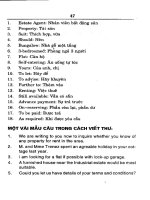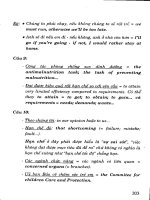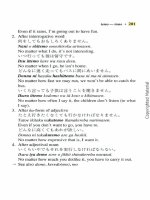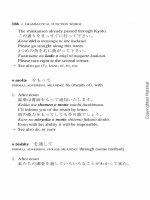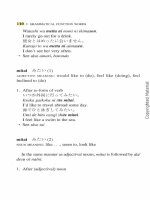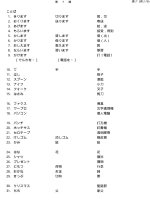Sound Patterns of Spoken English phần 7 doc
Bạn đang xem bản rút gọn của tài liệu. Xem và tải ngay bản đầy đủ của tài liệu tại đây (108.7 KB, 17 trang )
Experimental Studies in Casual Speech 91
While this is an attractive model, it is very difficult to apply in a
deterministic fashion, since our knowledge of the contribution of
the many variables to the articulation of each utterance is slight.
At present, it could be thought of as a qualitative rather than a
quantitative model.
2 Fowler’s gestural model (1985) is designed to explain both
speech production and perception. It postulates that speech is
composed of gestures and complexes of gestures. The limits of
these are set by the nature of the vocal tract and the human
perceptual system, but there is room within these limits for
variation across languages. Many languages could have a voice-
less velar stop gesture, for example, but the relationship among
tongue movement, velum movement, and laryngeal activity can
differ from language to language. These differences can in turn
account for differences in coarticulation across languages. Fowler
suggests that language is both produced and perceived in terms
of these gestures. Consequently, there is no need for a special
mapping of speech onto abstract language units such as distinc-
tive features: speech is perceived directly.
As mentioned in chapter 3 in our discussion of Browman and
Goldstein (who have a similar approach, though they regard it
as phonological rather than (or as well as) phonetic), gestures
can differ only in amplitude and in the amount with which they
overlap with neighbouring gestures. It is thus assumed that all
connected speech phenomena are explicable in terms of these two
devices, and is presumably further assumed that perception of
conversational speech does not differ significantly from perception
of careful or formal speech, since the same gestures are used in
each case.
The word
A very popular psycholinguistic model (or family of models) of
speech perception (Marslen-Wilson and Welsh, 1978; Cole and
Jakimik, 1978; Cutler and Norris, 1988, Norris, 1994) assumes
that the word is the basic unit of perception and that the mental
92 Experimental Studies in Casual Speech
lexicon is where sound and meaning are united. When this union
occurs, a percept is achieved.
A person hearing a new utterance will take in enough acoustic
information to recognize the first perceptual unit (sound, syllable,
stress unit). A subconscious search in the mental lexicon will bring
up all words beginning with this unit. These words are said to
be ‘in competition’ for the time slot. As the time course of the
phonetic information is followed and more units are perceived,
words which do not match are discarded. A word is recognized
when there are no other candidates (‘the isolation point’). When
recognition involves a grammatical unit such as a phrase or sentence,
semantic and syntactic analyses become stronger as the parse
progresses, so that fewer lexical items are brought up in any given
position, and recognition gets faster. There are a few additional
principles, such as that frequent words are easier to recognize than
unusual ones and words which have been used recently are easier
to recognize than words which are just being introduced into the
discourse.
This theory is different from several earlier ones because it is
largely automatic, i.e. it does not need a control device which com-
pares input with stored templates to decide whether there is a good
match: it simply works its way along the input until a winner is
declared. An ongoing argument in the word recognition literature
is to what extent phonetic information is supplemented by higher-
level (syntactic, semantic) information, especially at later stages in
the utterance (Cutler, 1995).
The psychological reality and primacy of the word is an essential
foundation of this theory, and especially the beginning of the word,
which is usually taken as the entry point for perceptual processing.
(Counterevidence exists: see Cutler, 1995: 102–3, but highest prior-
ity is still given in the model to word-initial information.) It is
perhaps no accident that most of the experimentation associated
with this model has been done in what Whorf (1941) called Standard
Average European languages and other languages where mor-
phology is relatively simple and the division between words and
higher-level linguistic units is relatively clear. It is arguable whether
it is a good perceptual model for, say, Russian, which has a number
of prefixes which can be added to verbs to change aspect (Comrie,
Experimental Studies in Casual Speech 93
1987: 340; Lehiste, personal communication) such that there will
be, for example, thousands of verbs beginning with ‘pro’, a perfective
prefix. Even English has several highly productive prefixes such as
‘un-’. Given a way can be found to ‘fast forward’ over prefixes (while
at the same time noting their identity), there may still be problems
for this model with languages such as Inuktitut, which has over
500 productive affixes and where the distinction between words and
sentences is very vague indeed: ‘Ajjiliurumajagit’ means, for example
‘I want to take your picture’, and ‘Qimuksikkuurumavunga’ means
‘I want to go by dogteam.’ The structure of the Inuktitut lexicon is
a subject far beyond the remit of this book, but it seems likely that
the lexical access model hypothesized for English will be heavily
tested by this language.
Another challenge to this model is presented by the perception
of casual speech which, as we have seen, often has portions
where acoustic information is spread over several notional segments
(so that strict linearity is not observed) or is sometimes missing
entirely.
4.2.2 Phonology in speech perception
Does it play a part at all?
Theories of word perception are largely proposed by psychologists,
who recognize the acoustic/phonetic aspects of sound but who (pace
those cited below) do not consider the place of phonology in speech
perception. Most models suggest that phonetic sounds are mapped
directly onto the lexicon, with no intermediate linguistic processing.
But to a linguist, it seems reasonable to suppose that phonologi-
cal rules or processes are involved both in speech production and
speech perception. Frazier (1987: 262) makes the ironic observa-
tion that it is generally agreed that people perceive an unfamiliar
language with reference to the phonology of their native language,
but it is not agreed that they perceive their native language with
reference to its own phonology. Frauenfelder and Lahiri (1989)
stress that the phonology of the language does influence how it
is perceived. For example (p. 331), speakers of English infer a fol-
lowing nasal consonant when they hear a nasalized vowel, while
94 Experimental Studies in Casual Speech
speakers of Bengali, which has phonemically nasalized vowels, do
not. Cutler, Mehler, Norris and Segui (1983) suggest that English-
speaking and French-speaking subjects process syllables differently.
Gaskell and Marslen-Wilson (1998: 388) conclude, ‘when listeners
make judgments about the identity of segments embedded in con-
tinuous speech, they are operating on a highly analyzed phonological
representation.’
It thus seems quite likely that phonology does play a part in
speech perception: we could say that access to the lexicon is
mediated by phonology: phonology gives us a variety of ways to inter-
pret input because a given phonetic form could have come from a
number of underlying phonological forms. We develop language-
specific algorithms for interpretation of phonetic input which
are congruent with production algorithms (phonological rules or
processes).
Both Frauenfelder and Lahiri (1989) and Sotillo (1997: 53) note
that there is one other basic approach to the problem of recognizing
multiple realizations of the same word form: rather than a single
form being stored and variants predicted/recognized by algor-
ithm as suggested above, all variants are included in the lexicon
(variation is ‘pre-compiled’). Lahiri and Marslen-Wilson (1991)
opine that this technique is both inelegant and unwieldy ‘given the
productivity of the phonological processes involved’. This theoreti-
cal bifurcation can be seen as a subset of the old ‘compute or store’
problem which has been discussed by computer scientists: is it easier
to look up information (hence putting a load on memory) or to
generate it on the spot (hence putting a load on computation)?
A non-generative approach to phonology involving storage of
variants (Trace/Event Theory) was discussed at the end of chapter
3 and will be discussed further below.
Access by algorithm
Lahiri and Marslen-Wilson (1991) suggest lexical access through
interpretation of underspecified phonological features (see chapter 3
for underspecification), an algorithmic process. They observe that
lexical items must be represented such that they are distinct from
each other, but at the same time they must be sufficiently abstract
Experimental Studies in Casual Speech 95
to allow for recognition of variable forms. Therefore, all English
vowels will be underspecified for nasality in the lexicon, allowing
both nasal and non-nasal vowels to map onto them. Some Bengali
vowels will either be specified [+nasal], allowing for mapping of
nasalized vowels which do not occur before nasals or unspecified,
allowing for mapping of both nasalized vowels before nasals and
non-nasalized vowels.
Similarly, English coronal nasals will be unspecified for place, so
that the first syllable of [cp}mbÑl] [cp}ºkäàn] and [cp}nhyd] can all
be recognized as ‘pin’. Marslen-Wilson, Nix and Gaskell (1995)
refine this concept by noting that phonologically-allowed variants of
coronals are not recognized as coronals if the following context is
not present, such that abstract representation and context-sensitive
phonological inference each play a part in recognition.
In allowing a degree of abstraction, this theory undoubtedly gets
closer to the truth than the simple word-access machine described
above, but at the expense of a strictly linear analysis. For example,
speakers of Bengali will have to wait to see whether there is a
nasal consonant following before assigning a nasalized vowel to the
[+nasal] or [−nasal] category, so recognition of a word cannot pro-
ceed segment by segment.
Late recognition: gating experiments
Gating is a technique for presentation of speech stimuli which is
often used when judgements about connected speech are required.
Normally, connected speech goes by so fast that hearers are not
capable of determining the presence or absence of a particular seg-
ment or feature. In gating, one truncates all but a small amount of
the beginning of an utterance, then re-introduces the deleted mater-
ial in small increments (‘gates’) until the entire utterance is heard.
This yields a continuum of stimuli with ever greater duration and
hence ever greater information. When gated speech is played to
subjects and they are asked to make a judgement about what
they hear, the development of a sound/word/sentence percept can
be tracked.
Word recognition often occurs later than the simple word-
recognition theory would predict. Grosjean (1980), for example,
96 Experimental Studies in Casual Speech
discovered that gated words taken from the speech stream were
recognized very poorly and many monosyllabic words were not
totally accepted until after their completion. Luce (1986) agrees
that many short words are not accepted until the following word is
known and concludes that it is virtually impossible to recognize a
word in fluent speech without first having heard the entire word as
well as a portion of the next word. Grosjean (1985) suggested that
the recognition process is sequential but not always in synchrony
with the acoustic-phonetic stream (though his own futher experi-
ments showed this to be inaccurate).
Bard, Shillcock and Altmann (1988) presented sentences gated in
words to their subjects. Although the majority of recognition out-
comes (69 per cent) yielded success in the word’s first presentation
with prior context only, 19 per cent of all outcomes and 21 per
cent of all successful outcomes were late recognitions.
These late recognitions were not merely an artefact of the inter-
ruption of word-final coarticulation. Approximately 35 per cent
of them were identified not at the presentation of the next word,
but later still. The mean number of subsequent words needed
for late identification was closer to two than one (M = 1.69,
SD = 1.32).
Their results suggested that longer words (as measured in milli-
seconds), content words, and words farther from the beginning
of an utterance were more likely to be recognized on their first
presentation. Short words near the end of an utterance, where the
opportunity for late recognition was limited, were more likely to
be recognized late or not at all.
My experiments
Experiment 1
How casual speech is interpreted has been one of my ongoing re-
search questions. In an early experiment (Shockey and Watkins, 1995),
I recorded and gated a sentence containing two notable divergences
from careful pronunciation. The sentence was ‘The screen play
didn’t resemble the book at all’, pronounced as follows:
[ÎvcskflHmply}d}
d
Úfl}z*mb<ÎvcbäkvtcÑÕ]
Experimental Studies in Casual Speech 97
The ‘n’ at the end of ‘screen’ was pronounced ‘m’ (so the word
was, phonetically, ‘scream’) and the word ‘didn’t’ was pronounced
[d}
d
Ú], where the second ‘d’ was a passing, short closure before
a nasal release and the final ‘t’ did not appear at all. The gates
began in the middle of the word ‘screen’ and were of approximately
50 msec. rather than being entire words.
At first, all subjects heard ‘screen’ as ‘scream’ which is altogether
unsurprising, as that is what was said. As soon as the conditioning
factor for the n → m assimilation appears, however, some subjects
immediately shift from ‘scream’ to ‘screen’ without taking into
account the identity of the following word. These ‘hair trigger’
subjects are clearly working in a phonological mode: their phono-
logical process which assimilates ‘n’ to ‘m’ before a labial ‘works in
reverse’ when the labial is revealed, as suggested by Gaskell and
Marslen-Wilson (1998). This seems good evidence of an active
phonology which is not simply facilitating matches with lexical
forms but which is throwing up alternative interpretations when-
ever they become possible.
One would predict that the strategy described above could prove
errorful in the case where a ‘m’ + ‘p’ sequence represents only itself.
In another experiment where the intended lexical item was ‘scream’
rather than ‘screen’ but the following environment was again a ‘p’
(‘The scream play was part of Primal Therapy’), it was discovered
that some subjects indeed made the ‘m’ to ‘n’ reversal on phonetic
evidence and had to reverse their decision later in the sentence.
In experiment 1, other subjects waited until the end of the word
‘play’ to institute the reversal of ‘m’ to ‘n’ but most had achieved the
reversal by the beginning of ‘didn’t’. Subjects who wait longer and
gather more corroborating evidence from lexical identity and/or
syntactic structures are clearly using a more global strategy.
With the word ‘didn’t’ it is apparent that the results reflect such
a global judgement: the word is much more highly-reduced than
‘screen’ and the time span over which it is recognized is much greater.
Three subjects did not identify the word correctly until after the
word ‘book,’ and only one subject recognized the word within its
own time span. Interestingly, the subjects who did not arrive at a
correct interpretation of the entire sentence were those who did not
apply the global technique: they arrived at an incorrect interpretation
98 Experimental Studies in Casual Speech
early on and did not update their guess based on subsequent
information.
Results of this experiment thus suggested that there is a class of
very simple phonological processes which can be ‘reversed’ locally,
but that processes which seriously alter the structure of a word
need to be resolved using a larger context.
Experiment 2
Experiment 1 was criticized on two grounds: (1) the sentence used
was not a sentence taken from natural conversation, hence results
yet again reflected perception of ‘lab speech’; and (2) the speaker in
this case had an American accent, but the subjects were users of
British English. Conversational processes might be different for the
two varieties, and if so this would interfere with identification of
the sentence by British subjects.
With these in mind, I chose a sentence from a recorded mono-
logue taken from a native speaker of Standard Southern British,
gated it using 50 msec. gates from very near the beginning, and
presented the result, interspersed with suitable pauses, to a new
group of users of Southern British.
The sentence was ‘So it was quite good fun, actually, on the
wedding, though.’ It was pronounced:
[s
w
}
w
v
w
sckwa}ˆìä!f.næ Ääw}∞n<vcwyd÷º:âÍ]
This sentence was chosen for three main reasons: (1) it was one of
the few from the recordings of connected speech I had collected
which seemed clearly understandable out of context, (2) it contained
familiar casual speech reductions, presumably having as a basis:
[svä}twvzckwa}tìädfÎnækàävli∞nÎvcwyd÷ºÎvä]
and (3) it had a slightly unusual construction and the major informa-
tion came quite late in the sentence. This meant that the well-
known phenomenon of words being more predictable as the sentence
unfolds was minimized.
Despite the match between accent of speaker and hearer, scores
on perception of the sentence were not perfect: mistakes took place
Experimental Studies in Casual Speech 99
at the very-much-reduced beginning of the sentence, as seen below.
Here are examples of answer sequences from non-linguists:
Subject A
1i
2 pee
3 pquo
4 pisquoi
5 pisquoi
6 pisquoit
7?
8 pisquoifana
9 pisquoifanat
10 pisquoifanactually
11 etc. along the same lines . . .
20 He’s quite good fun, actually, on the wedding day.
Subject B
1tu
2 tut
3 uka
4 uzka
5 she’s quite
6 she’s quite a
7 she’s quite a fun
8 she’s quite a fun ac
9 she’s quite good fun, ac
10 so it was quite good fun, actually . . .
Following is an example of an answer sheet from a subject who also
was a phonetician and could use phonetic transcription to reflect
the bits which were not yet understood:
1 tsu
2 tsut
3 tsuk∞
4 tsuzk∞
5 she’s quite
100 Experimental Studies in Casual Speech
6 she’s quite a
7 she’s quite a fun
9 she’s quite good fun ac . . .
10 so it was quite good fun, actually on
The major feature of these responses is disorientation until gate 10
(20, the last gate, for subject A), when the correct response sud-
denly appears and in a way which seems only indirectly related to
earlier responses.
Experiment 3
I thought that my subjects might be limited in their responses by
the spelling system of English, so constructed the following para-
digm: the listener first hears a gated utterance, then repeats it, then
writes it. My line of reasoning was that even if they could not use
phonetic transcription, the subjects could repeat the input accu-
rately, and I could transcribe it phonetically, thus getting a clearer
insight into how the percept was developing.
For this task, a short sentence was used ‘And they arrived on the
Friday night.’ It was produced as part of a spontaneous monologue
by a speaker of Standard Southern British, isolated, and gated from
the beginning. A reasonably close phonetic transcription is:
<:y}ga}vd∞<:vcffla}d}cna}]
In this sentence ‘and’ is reduced to a long dental nasal, ‘and they’
shows Î-assimilation, the [vfl] sequence in ‘arrived’ is realized as [g],
and ‘on the’ is realized with Î-assimilation. Much of the reduction
is at the beginning of the sentence, which makes the task harder.
Subjects, in fact, found the whole experience difficult (even though
many of them were colleagues in linguistics), and nearly everyone
forgot to either speak or write in one instance. With hindsight, I
think the task is too difficult, and future experiments should ask
for either repetition or writing, not both. It is also not clear that the
spoken response adds anything to what can be gleaned from the
orthographic version, even though they are often different.
There were ten gates in all. Table 4.1 shows selected results from
five of them.
Experimental Studies in Casual Speech 101
Table 4.1 Listeners’ transcriptions of gated utterances
Gate no. My transcription They said Their transcription
1[<ˆ] -nn
mum
m¥bm mb
∂mˆ —
mm
unn
¢jv na
ˆ%ºˆ un
4 <:y}v nyˆ nek
my mare
vm-ˆ uhmay
m:y} mayb
nyæä now
6 <:y}gay nyflv neero
myflæ mare I
fflvmÎyflw from there I
naäfla}ˆ now ri
m:yflv mara
m:y}fla} mayro
8 <:y}ga}vd nyflav neero
myfla} mare I
Îyfla}v they arrive
my}a}fla}] may I write
miww} may why
wvny}ga}vd when they arrived
9 <:y}ga}vd∞nny}ga}vt
h
neerived
wvnÎy}ga}vd∞n when they arrived on
vndÎy}ga}vd∞n and they arrived on
myfliga}vd∞n Mary arrived on
my}ga}vd∞n May arrived on
102 Experimental Studies in Casual Speech
At Gate 10, there were 3 main interpretations:
(a) And they arrived on the Friday night 40 per cent
(b) May arrived on the Friday night 27 per cent
(c) When they arrived on the Friday night 20 per cent
The major causes of the misinterpretations were (1) wrong begin-
ning, (2) inattention to suprasegmentals/assimilation and (3) incor-
rect choice of phonological expansion.
The first of these causes bears out the claim that beginnings of
utterances are especially important. Most of the people who arrived
at interpretation (a) heard a labial section at the beginning of the
utterance and stuck to this interpretation throughout.
The second problem prevented listeners from hearing ‘and they’
at the beginning of the sentence, since the ‘and th . . .’ part was
encoded in the long dental [n].
Interpretation (c) was also related to the perceived labiality at
the beginning of the utterance, but rather than interpret it as [m]
(and probably because of the exceptional length of the first nasal),
what they took to be a labialized nasal was interpreted as the word
‘when’. This again demonstrates an active use of phonology to
reinvent the probable source of the reduction, similar to the situ-
ation described in the erroneous ‘m + p’ interpretations above.
Word recognition?
It is not surprising that some aspects of these results are incom-
patible with a strict word-recognition framework: since there were
no complete words at the beginning, the subjects did not show a tend-
ency to recognize the input as words until well into the utterance.
The phonological changes Gaskell and Marslen-Wilson deal
with in their papers are minimal – place of articulation for stops,
nasalization for vowels – so the words they were investigating were
only mildly different from the full lexical entry (and the same can
be said for Cutler, 1998, where she lists phonological reductions
which will not create difficulties for word recognition). A distinc-
tion must be made between these minor changes in pronunciation
and major structural changes such as seen in ‘and they’ in the
Experimental Studies in Casual Speech 103
present experimental sentence: the phonetic output represents words,
but not in a way which allows a straightforward interpretation.
These naturally offer a much greater challenge to perception.
Situations such as the example shown below, where a subject
finds a word, changes his mind, and goes back to a non-word, were
also found.
1n
2ne
3 nek
4 nek
5 neer
6 neero
7 neer eye
8 neerive
9 neerived
10 and they arrived on the . . .
One might conclude that though there may be a preference for
understanding utterances word by word and that this is the un-
marked strategy when listening to clear speech, perceivers of casual
speech seem quite comfortable with building up an acoustic sketch
as the utterance is produced, the details of which are filled in when
enough information becomes available, exactly as suggested by
Brown (p. 4) in 1977. Bard (2001, personal communication) and
Shillcock, Bard and Spensley (1988) interpret this perceptual strat-
egy as one of finding the best pathway through a set of alternative
hypotheses which are set up as soon as the input begins, similar to
the ‘chart parsing’ or ‘lattice’ techniques used in speech recognition
by computer (e.g. Thompson, 1991). But the striking change at
gate 9 or 10 between ‘interpretation as gibberish’ and ‘sensible
interpretation’ suggests to me that no viable hypotheses were actu-
ally being made at the beginning of the utterance. (Bard claims that
the hypotheses have been in place all along, but are not consciously
accessible. Whether this can be true of the type of sentence used in
experiments 2 and 3 is an empirical question.) To all appearances,
rather than having been perceived word by word, the whole sentence
104 Experimental Studies in Casual Speech
suddenly comes into focus. The results thus encourage us to con-
sider a model where interpretation of a whole utterance is not
possible until one gets enough distance from it to be able to see
how the parts fit together, i.e. a gestalt pattern perception.
Taking the many complex cues in our sentence (And they
arrived . . . ) into account, one can easily see why a significant span
of speech must be taken in before interpretation can be accurate.
For example, the initial nasal is long, which could simply mean
that the speech is slow. We need to get more information about the
rate and rhythm of the utterance before it becomes obvious that
the [n:] is relatively longer than a normal initial [n]. By the time we
can make this judgement, we may also be able to detect that the
initial nasal is dental rather than the expected alveolar. This, too,
will be difficult to judge at the absolute onset of the utterance: we
must home in on the speaker’s articulatory space.
Psycholinguists accept that suprasegmental aspects of speech are
important for perception (see Cutler, Dahan and van Donselaar,
1997 for a review) and Davis (2000) points out that short words
(such as ‘cap’) extracted from longer words (‘captain’) are recog-
nizably different in temporal structure from the same short words
said on their own (cf. Lehiste, 1972; Port, 1981). However, little
has been made of the fact that suprasegmental features such as
timing and intonation are often preserved when segmental informa-
tion is reduced and that this may help to account for the very high
intelligibility of reduced speech.
4.2.3 Other theories
Other psycholinguistic theories offer potentially fruitful approaches
to understanding perception of casual speech.
Warren, Fraser
Richard Warren is best known for his work on phonemic restora-
tion (Warren, 1970; Warren and Obusek, 1971) in which he showed
that when a cough or noise is substituted for a speech sound,
listeners not only ‘hear’ the sound which was deleted, but have no
Experimental Studies in Casual Speech 105
idea where in the utterance the extraneous noise occurred. His
work reflects a general interest in speech and music perception, and
especially in how very fast sequences of different sounds can be
heard accurately. While most theories of speech perception assume
that speech is understood in the order it is produced, Warren has
shown that perceivers can accurately report the presence of, say, a
beep, a burst of white noise, and a click in rapid succession with-
out being able to report accurately the order in which they occur.
Hearers can thus report that the sounds were there, but not neces-
sarily in what order. This may be a useful technique in the speech
domain when perceiving sequences such as [kbˆ] (‘can’t’), where
the original order of elements is changed.
Working in a phonemic restoration framework, Warren also
showed that listeners can defer the restoration of an ambiguous
word fragment in a sentence for several words, until enough
context is given to allow for interpretation. ‘The integration of
degraded or reduced acoustic information permits comprehension
of sentences when many of the cues necessary to identify a word
heard in isolation are lacking’ (Warren, 1999: 185). Warren’s expla-
nation of this is that holistic perception is active: no interpreta-
tion of input is achieved until an accumulation of cues allows one
to suddenly understand the entire pattern (Sherman, 1971 cited in
Warren, 1999). Supporting evidence comes from reports of railroad
telegraphers (Bryan and Harter, 1897, 1899, reported in Warren,
1999: 184) who usually delayed several words before transcribing
the ongoing message. ‘Skilled storage’, as he terms it, has been
observed in other domains such as typing and reading aloud. As
supporting evidence, he cites Daneman and Merikle (1996), who
convincingly argue that measures that tax the combined processing
and storage resources of working memory are better predictors of
language comprehension than are measures that tax only storage.
Fraser (1992), basing her arguments on phenomenological philos-
ophy, makes a congruent claim, i.e. that linguists are mistaken
about what is Objectified by perceivers of speech: phonemes and
even words may not be isolable until the entire utterance in which
they are contained is understood. Words are accessible through
meaning rather than vice versa.
106 Experimental Studies in Casual Speech
Massaro and FLMP
Massaro (1987) proposed a model which could be said (though
not overtly by Massaro) to function holistically in the sense indi-
cated by Warren. The Fuzzy Logical Model of Perception (FLMP)
assumes that input is processed in terms of perceptual features
(which are not necessarily the distinctive features proposed in pho-
nology) and that a percept is achieved via the values of these
features. A particular percept is not linked to a single feature
configuration, which allows for compensatory effects. It has been
shown that stress in English, for example, may be cued by a com-
bination of change in fundamental frequency, change in duration,
change in amplitude, and change in the speech spectrum (e.g. in
vowel formant values). A percept of stress may be achieved by a
little bit of each of these, a moderate amount of any two of these,
or a lot of one. Massaro’s model allows for tradeoffs of this sort
as well as tradeoffs involving different sensory modes, principally
hearing and vision. The aspect of this model which interests us
here is that it can build up a profile of the input without making
any definite decisions until necessary, just as our subjects seem to be
doing in the perception of casual speech.
Hawkins, Smith and Polysp
Hawkins and Smith (2001) have outlined a model (Polysp) which
takes into account that decisions about many linguistic constructs
require considerable context. They emphasize that speech perception
involves relative rather than absolute decisions and come out against
‘short-domainism’ (p. 101). They note that ‘knowing about words
and larger structures makes it easier to interpret allophonic detail and
vice versa.’ Perceptual cohesion (that which makes speech natural-
sounding and interpretable) is rooted in the sensory signal, but relies
on knowledge. While approaching speech perception from experi-
ments based only marginally on the perception of casual speech,
Hawkins and Smith also conclude that ‘understanding linguistic
meaning appears to be very much dependent on the “Gestalt” con-
veyed by the whole signal rather than on the gradual accumulation
of information from a sequence of quasi-independent cues’ (p. 112).
Experimental Studies in Casual Speech 107
Access using traces: something completely different?
In chapter 3, we reported that one way to deal with casual speech
phonology is to assume that traces are stored in the mental lexicon
each time a word is heard. These traces will retain indexical informa-
tion such as the speaker and the social milieu in which the word
was uttered. Traces can be equally well used for speech recognition:
every time a word which matches a trace in the lexicon is heard,
the trace is activated. If it is adequately stimulated, the result will
be a percept of the word associated with the trace, accompanied by
its meaning. This is a passive model of language perception, as it
relies on activation rather than rule application. It has its intellectual
heritage in the Parallel Distributed Processor (PDP) model described
below: the tokens acquired through day-to-day social interaction
serve as the training phase and a brand new token brings about the
testing phase, when it is assumed that the new material will stimulate
a trace or a group of traces in the lexicon, consequently ‘outputting’
a percept.
In this model, variation is not represented through phonological
rules or processes, but is present within lexical items themselves: a
variant has the same relationship to the semantic part of the entry
as the citation form, which might be thought of as ‘first among
equals’.
A model of this sort was tested by Gaskell, Hare and Marslen-
Wilson (1995), using a Parallel Distributed Processor (‘neural net’).
This is a computer-based device which can ‘learn’ to map inputs
into outputs. Say, for example, you wanted the PDP to output
‘two’ whenever ‘deux’ is input. You specify ‘two’ as the correct
output, train it on multiple tokens of ‘deux’, and then test it with a
new token of ‘deux’. If it outputs the wrong thing, you correct it,
and it changes its internal values in accordance with your correc-
tion. This is the sense in which ‘learning’ is used here. Note that
the relationship between the input and output of this device is
completely arbitrary: if I wanted the output ‘§’ to occur when the
input is ‘phlogiston’, the device would comply as long as I trained
it properly.
A multi-layered PDP system has been constructed by McClelland
and Elman (1986), each layer representing a level of linguistic



